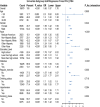Association between fibrosis-4 index and coronary heart disease: a population-based study
- PMID: 41013299
- PMCID: PMC12465867
- DOI: 10.1186/s12872-025-05166-w
Association between fibrosis-4 index and coronary heart disease: a population-based study
Abstract
Although the fibrosis-4 index (FIB‐4) was initially established as a liver fibrosis marker, recent studies have demonstrated its significant association with elevated risk of coronary artery disease(CHD). This study was conducted using data from five National Health and Nutrition Examination Surveys (NHANES) cycles between 2009 and 2018. Multivariable logistic regression analysis revealed a significant, positive relationship between FIB-4 and CHD.In sensitivity analyses, the highest FIB-4 quartile (Q4) showed a 4.22-fold increased CHD risk versus Q1 (OR = 4.22, 95% CI:1.93–9.24, P = 0.0005), with significant dose-response trends across quartiles (P < 0.05). Receiver operating characteristic (ROC) analysis revealed FIB-4 had good discriminative power for CHD (AUC = 0.80, 95%CI:0.78–0.81), with 75.9% sensitivity and 30.2% specificity at the optimal cutoff of 1.31. Restricted cubic splines (RCS) analysis revealed a nonlinear dose-response relationship between FIB-4 and CHD risk (P < 0.0001), with accelerated risk elevation beyond the inflection point (FIB-4 = 2.73). Subgroup analyses confirmed FIB-4’s robust association with CHD risk (overall OR = 1.66, 95%CI:1.57–1.76), with stronger effects in males (vs. females, Pinteraction = 0.042), non-diabetics (vs. diabetics, Pinteraction < 0.001), and racial minorities (highest OR = 2.36 in ‘Other Race’).These findings underscore the potential of FIB-4 as a novel biomarker for CHD risk assessment in clinical practice.
Keywords: Adults; Coronary heart disease; Cross-sectional analysis; FIB-4; NHANES.
Conflict of interest statement
Declarations. Ethics approval and consent to participate: The NHANES study protocol received approval from the National Center for Health Statistics Institutional Review Board, with all participants providing written informed consent in compliance with institutional and regulatory requirements. Consent for publication: Not applicable. Competing interests: The authors have no relevant financial or non-financial competing interests to declare.
Figures
References
-
- Roth GA, Mensah GA, Johnson CO, Addolorato G, Ammirati E, Baddour LM, et al. GBD-NHLBI-JACC global burden of cardiovascular diseases writing group. global burden of cardiovascular diseases and risk factors, 1990–2019: update from the GBD 2019 study. J Am Coll Cardiol. 2020;76(25):2982–3021. - PMC - PubMed
Grants and funding
- No.242102310548/Science and Technology Research Project of Henan Province
- No.2023ZD0505703/National Science and Technology Major Project of the Ministry of Science and Technology of China
- No. 244200510002/Zhongyuan Leading Talents Program of Science and Technology Innovation
- No.232301420021 and No.242301420108/Joint Fund for Science and Technology Research and Development Program of Henan Province
- No. 242300420109/Natural Science Foundation of Henan Province
LinkOut - more resources
Full Text Sources





